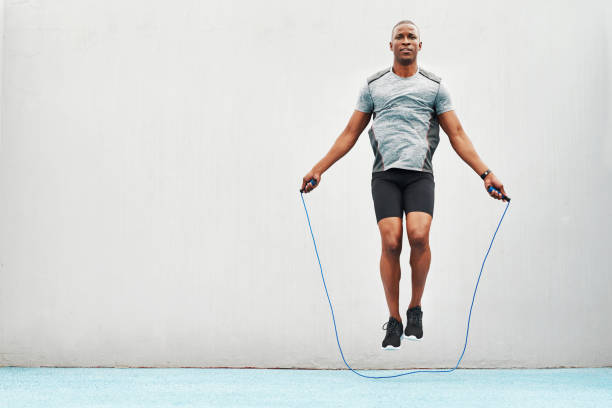Do you want to know how to lose weight by jumping rope? It’s not as hard as you might think! In this blog post, we will discuss the basics of how to start jumping rope to lose weight, as well as what you need to get started. We’ll also provide a few tips on how to make the most of your jump rope workouts. So if you’re looking for a fun and challenging way to shed some pounds, read on!
Contents
What Is Jumping Rope?
 Jumping rope is a simple yet effective cardio workout that can help you burn calories and lose weight. It is also a great way to tone your legs, arms, and core muscles. Jumping rope is a low-impact exercise, which means it is easy on your joints and suitable for people of all fitness levels.
Jumping rope is a simple yet effective cardio workout that can help you burn calories and lose weight. It is also a great way to tone your legs, arms, and core muscles. Jumping rope is a low-impact exercise, which means it is easy on your joints and suitable for people of all fitness levels.
Additionally, jumping rope is a portable workout that you can do anywhere, anytime. All you need is a jump rope and a little space! You can even jump rope indoors on a rainy day or when it’s too hot to exercise outside.
Jumping Rope And Weight Loss
Jumping rope is an excellent exercise for weight loss. A 155-pound person can burn approximately 200 calories in just 20 minutes of jumping rope. That’s the same as running at a six-mile-per-hour pace!
To lose one pound of fat, you need to create a calorie deficit of 3500 calories. So, if you jump rope for 30 minutes every day, you could lose one pound of fat in about two weeks. Of course, this will vary depending on your diet and how many other exercises you’re doing. But even if you only jump rope for a few minutes each day, it can still help you lose weight over time.
Benefits Of Jumping Rope
In addition to weight loss, jumping rope provides many other health benefits. Some of these benefits include:
Improved cardiovascular health
Cardiovascular health is the health of your heart and blood vessels. Jumping rope is a great cardiovascular workout because it gets your heart rate up and keeps it up for an extended period of time. This type of exercise can help to improve your overall cardiovascular health and reduce your risk of heart diseases like heart attacks and strokes.
Improved balance
Balance is the ability to maintain your center of gravity while moving or standing still. Jumping rope can help to improve your balance by challenging your proprioception (the ability to sense the position of your body in space). This is due to the fact that jumping rope requires you to constantly adjust your body position in order to keep the rope from hitting the ground.
Improved coordination
Coordination is the ability to use your body parts together smoothly and efficiently. Jumping rope requires coordination between your arms, legs, and feet. As you become more skilled at jumping rope, you will develop better coordination and timing. This can help you in other areas of life that require good coordination, such as playing sports or dancing.
Lowered blood pressure
 Blood pressure is the force of blood against your artery walls. High blood pressure can lead to heart disease, stroke, and other health problems. Exercise like jumping rope can help to lower blood pressure by making your heart stronger and more efficient at pumping blood. It can also help to reduce the number of stress hormones in your body, which can further lower blood pressure.
Blood pressure is the force of blood against your artery walls. High blood pressure can lead to heart disease, stroke, and other health problems. Exercise like jumping rope can help to lower blood pressure by making your heart stronger and more efficient at pumping blood. It can also help to reduce the number of stress hormones in your body, which can further lower blood pressure.
Reduced bad cholesterol levels
Cholesterol is a type of fat that can build up in your arteries and cause heart disease. There are two types of cholesterol: LDL cholesterol and HDL cholesterol. LDL cholesterol is the “bad” type of cholesterol that can build up in your arteries and cause heart disease. Jumping rope can help to reduce LDL cholesterol levels and improve your overall cholesterol profile that is, the ratio of LDL to HDL cholesterol.
Improved bone density
Bone density is the number of minerals, such as calcium, in your bones. As you age, your bones can become less dense and more likely to break. Jumping rope can help to improve bone density by putting stress on your bones that makes them stronger. This type of exercise is especially important for women who are at risk for osteoporosis.
These are just some of the many benefits that jumping rope can provide. If you are looking for a great workout that can help you lose weight, improve your cardiovascular health, and more, then jump rope is a great option for you.
Jumping Rope Technique
Now that you know some of the benefits of jumping rope, let’s go over the proper technique. Few people jump rope correctly, which can lead to inefficient workouts and even injuries. Here are some tips for jumping rope correctly:
- Keep your hands at your sides and close to your body. You should be holding the rope handles in each hand with your palms facing down.
- Jump lightly off the ground. You should be using your toes and balls of your feet to jump, not your heels. You should also be landing on the balls of your feet as well.
- Keep your jumps consistent. Each jump should be the same height and distance apart. This will help you maintain a good rhythm while you’re jumping.
Jumping Rope Tips For Beginners
If you’re just starting out, there are a few things you can do to make jumping rope easier. Some tips for beginners include:
Start with a slow rope
A slow rope is a rope that has a lower speed than a standard jump rope. This will help you get used to the rhythm of jumping without having to worry about going too fast.
Use a shorter rope
A shorter rope will be easier to control than a longer one. You can always cut down a standard jump rope to the length you need.
Warm-up before you jump
Jumping rope is a cardio workout, so it’s important to warm up your muscles before you start. A simple way to do this is to jump in place for a minute or two before you start jumping with the rope.
Jump in short bursts
When you’re first starting out, try jumping for 30 seconds and then resting for 30 seconds. As you get better, you can increase the amount of time you jump and decrease the amount of time you rest.
Jump on a soft surface
Jumping on a hard surface like concrete can be tough on your joints. If possible, try to jump on a softer surface like grass or a gym floor.
Take a break
If you start to feel pain in your muscles or joints, take a break. It’s important to listen to your body and rest when you need to.
Cool down after you jump
Just like it’s important to warm up your muscles before you jump, it’s also important to cool them down afterward. Jumping rope can be tough on your muscles and joints, so it’s important to stretch after your workout.
Jumping rope is a great way to get your heart rate up and lose weight. And the best part is, it’s a low-impact workout that you can do anywhere, anytime.
How Many Calories Does Jumping Rope Burn?
 The number of calories you burn while jump roping will depend on your weight, and intensity level, and Jump rope burns approximately 11 calories per minute, making it a great workout for weight loss!
The number of calories you burn while jump roping will depend on your weight, and intensity level, and Jump rope burns approximately 11 calories per minute, making it a great workout for weight loss!
To give you an idea of how many calories you can burn in 30 minutes of jumping rope, a 120-pound person will burn around 330 calories, while a 155-pound person will burn around 422 calories. A 185-pound person will burn around 510 calories in the same amount of time.
As you can see, jump roping is an excellent way to torch some serious calories! And the more weight you lose, the easier it will be to jump rope for longer periods of time and burn even more calories.
How to Start Jumping Rope
Now that you know all the benefits and techniques of jumping rope, you might be wondering how to get started. Luckily, it’s easy! All you need is a good pair of shoes and a jump rope. You can find a jump rope at your local sporting goods store or online.
When choosing a jump rope, look for one that is adjustable so you can customize the length to fit your height. Also, make sure the handles are comfortable to grip and not too slippery. Once you have your jump rope, it’s time to start jumping!
If you’ve never jumped rope before, start by practicing basic jumps without swinging the rope. A few steps to follow are:
- Stand with your feet shoulder-width apart and the rope behind you.
- Bend your elbows so they’re at a 90-degree angle and bring your hands up to eye level.
- Swing the rope over your head and jump as it comes toward your feet.
- Land lightly on the balls of your feet and immediately jump again.
- As you get better, you can start to swing the rope as you jump.
Once you get comfortable with basic jumps, you can start adding in some fancy moves like double under (jumping twice for every revolution of the rope) or crossover jumps (crossing your arms in front of your body as you jump). You can also try different types of jumps, such as side-to-side hops or power jumps (explosive jumps that require more effort).
How To Avoid Common Jumping Rope Mistakes?
 One of the most common mistakes people make when jumping rope is using their arms instead of their legs. Remember, your legs are the powerhouse here, so be sure to use them to jump. Using your arms will only tire you out and won’t help you burn as many calories.
One of the most common mistakes people make when jumping rope is using their arms instead of their legs. Remember, your legs are the powerhouse here, so be sure to use them to jump. Using your arms will only tire you out and won’t help you burn as many calories.
Another common mistake is not jumping high enough. You should be aiming to jump about an inch or two off the ground. This may not seem like much, but it’s important to get those jumps in!
Finally, be sure to keep your shoulders down and relaxed as you jump. Many people tend to hunch their shoulders when they get tired, but this will only make the workout more difficult.
So there you have it! Everything you need to know about jump roping for weight loss. Now get out there and start jumping!
Conclusion
Jumping rope is a great way to lose weight and get in shape. It’s easy to start, and you don’t need much equipment. Just a jump rope and some comfortable shoes. Start slowly and build up your stamina. And be sure to warm up before you jump.
In conclusion, jumping rope can help you lose weight, get in shape, and improve your coordination. It’s a great workout for both your upper and lower body. And it’s a lot of fun too! So get out there and start jumping today!
For more tips on healthy workout plans for weight loss, contact Mantra Care. We can help you develop a healthy weight loss program that is tailored to your specific needs and goals. You can also consult with a registered dietitian or nutritionist through our online nutrition counseling program if you have any questions or concerns about starting a new diet.


